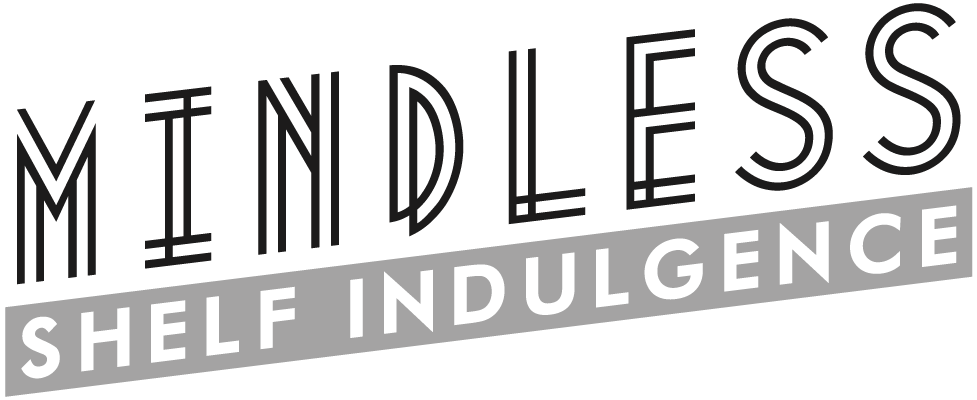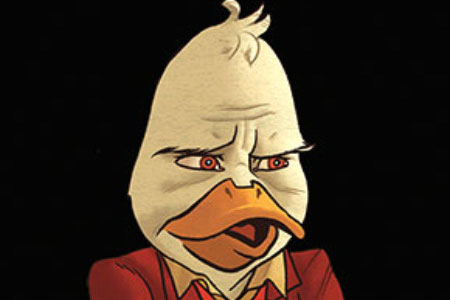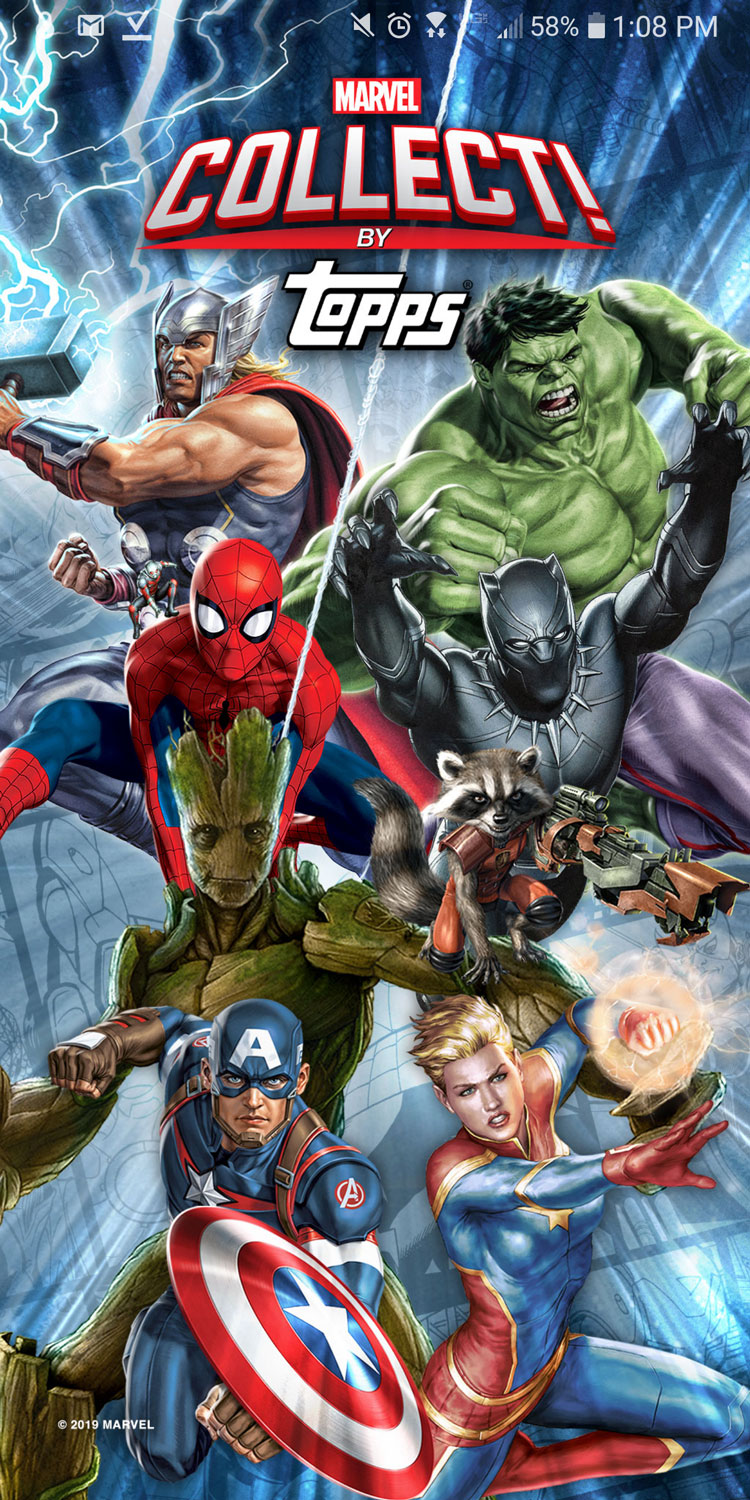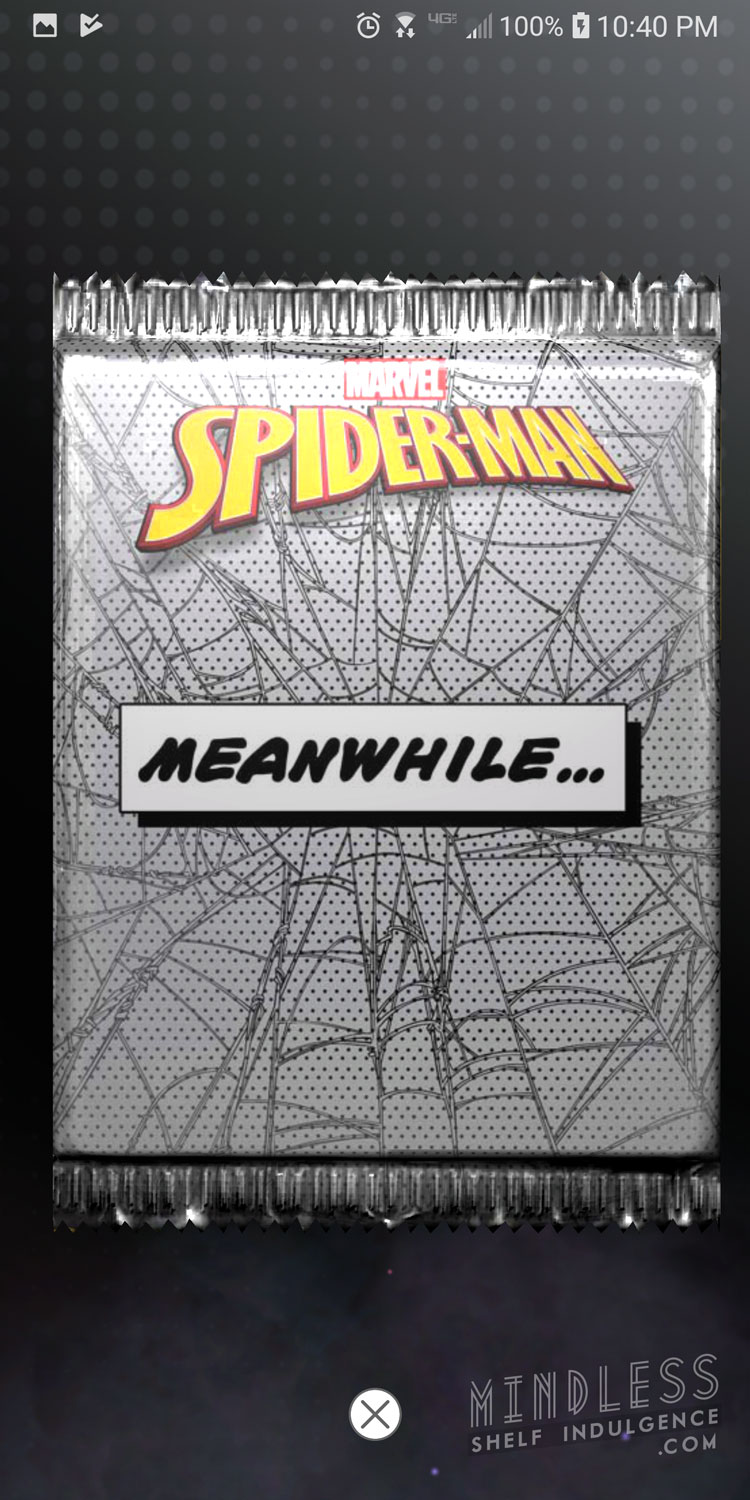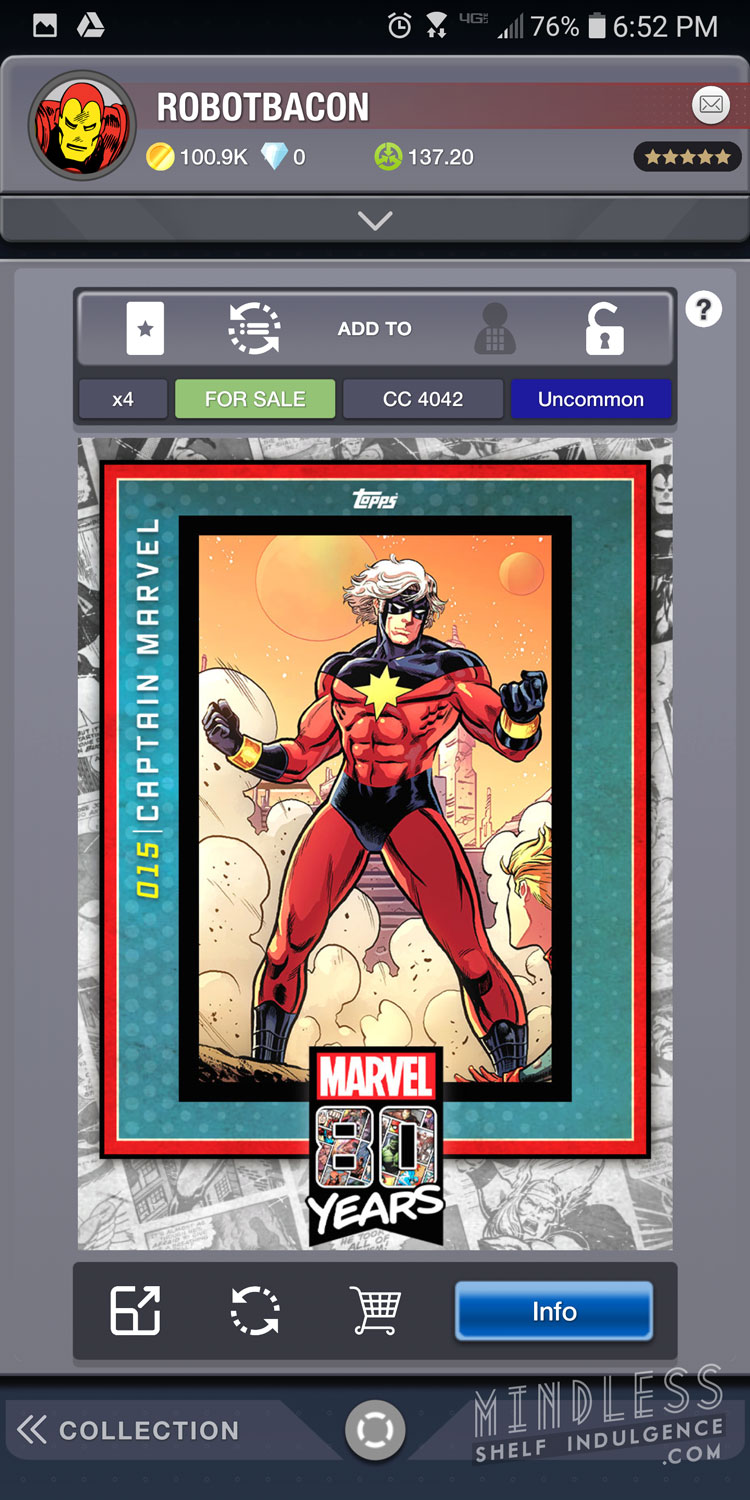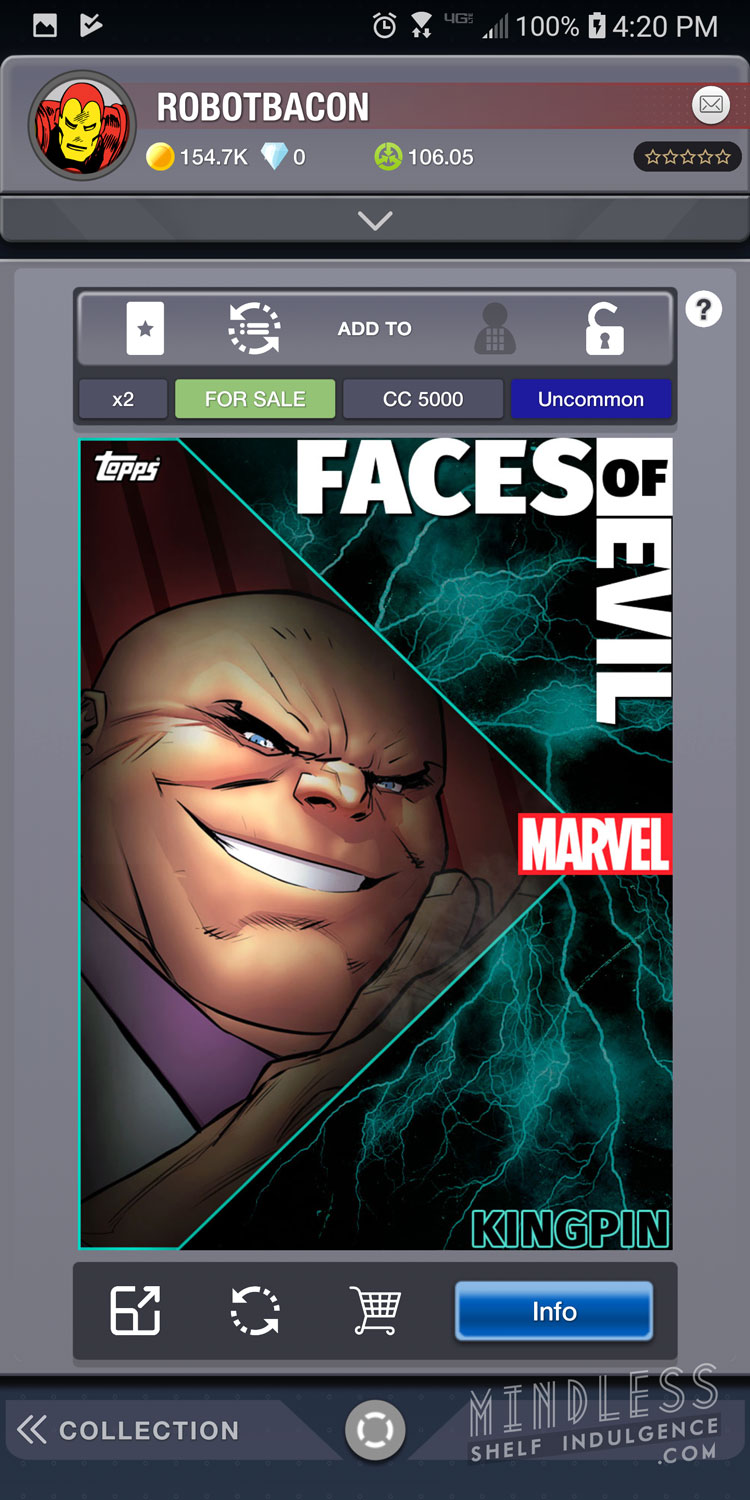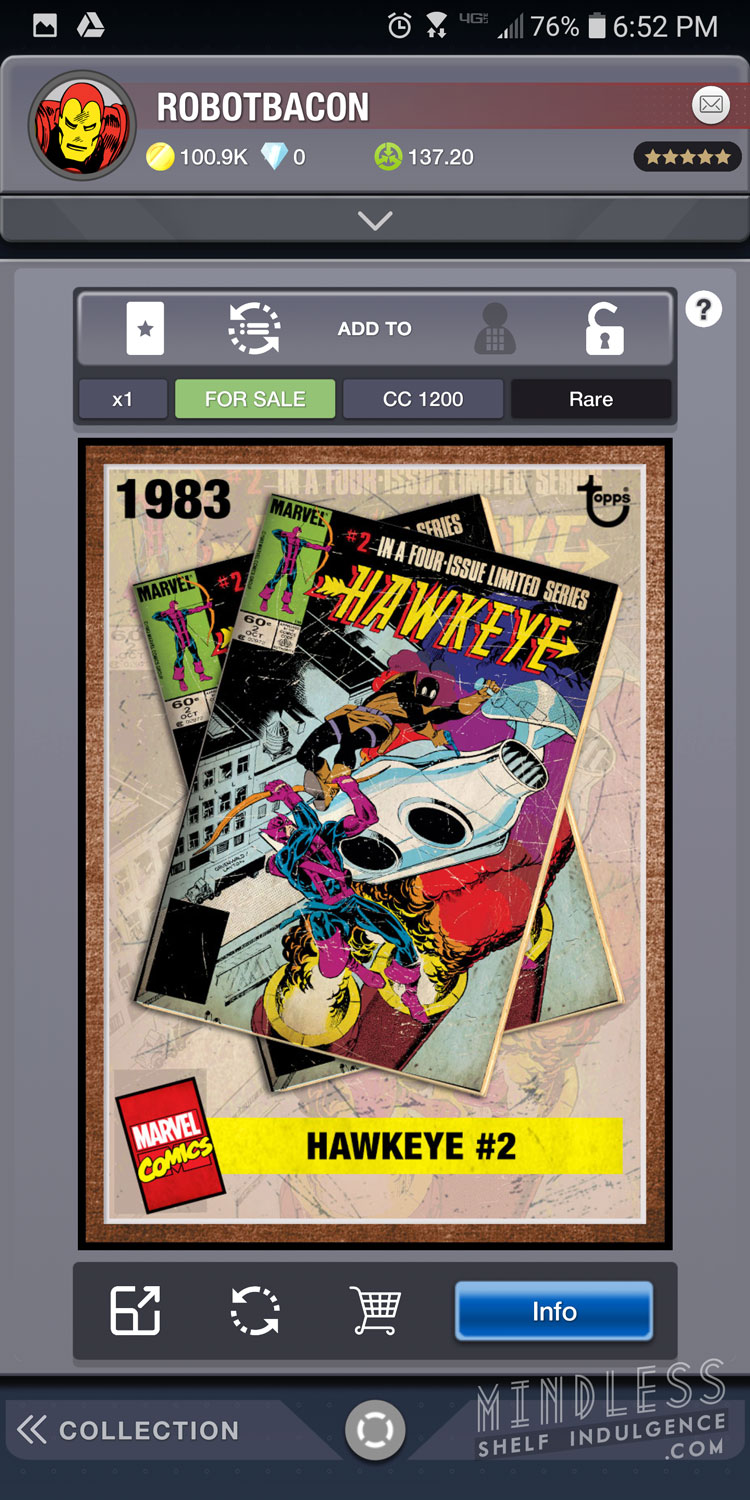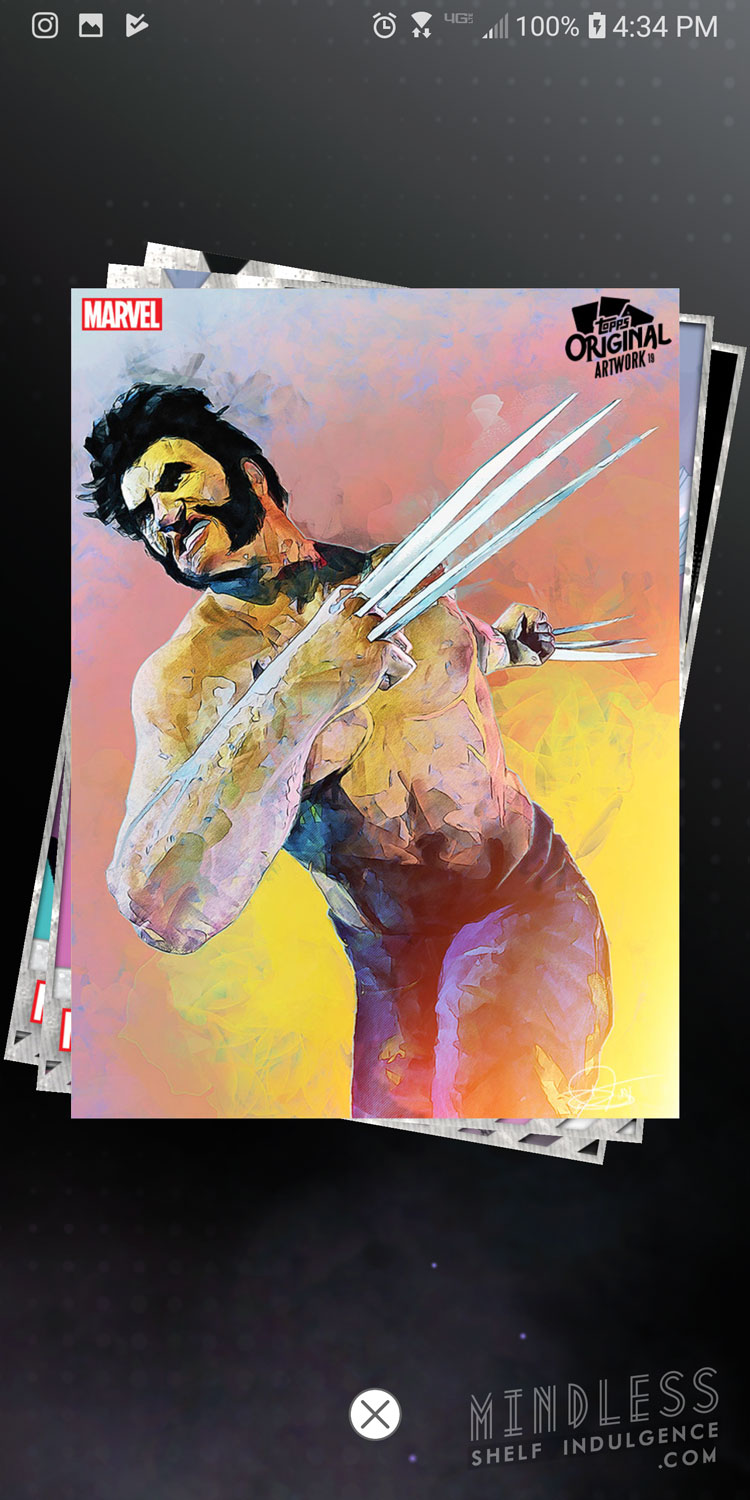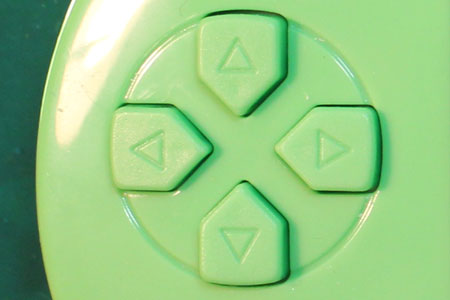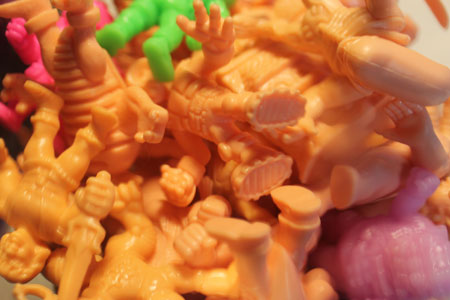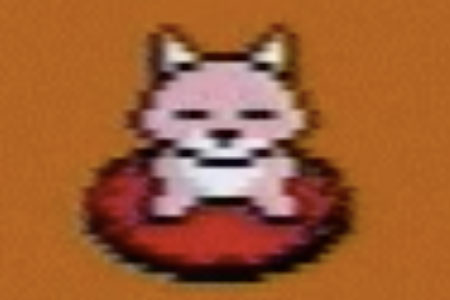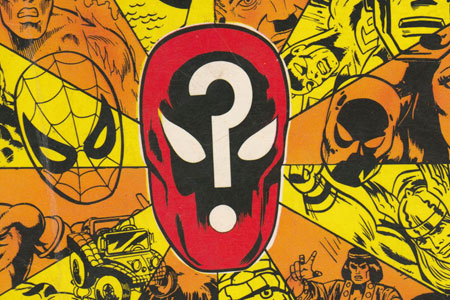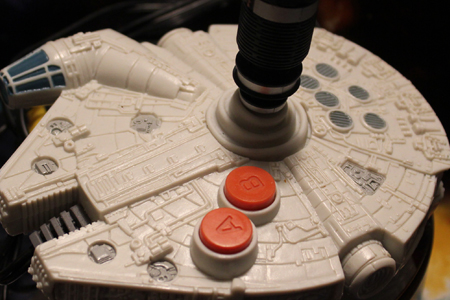
If you were a nerd in the ’90s, or even a half-nerd, you probably had stacks and stacks of Marvel Universe trading cards. If you were unlucky, a lot of them were goofy fly-by-night characters that Marvel was looking to make big, like Sleepwalker and Weapon Omega or Elektra. You heard it here: Elektra sucks.
If you were really lucky, you’d pulled a few sweet-ass holograms from those packs and hid them far, far away from the sticky-fingered neighbor kids. But cards, as small as they are, take up space. The square feet of living space that can be usurped by trading cards can be surprisingly immense for things that measure less than a millimeter thick. It’s truly insidious. What’s a collector to do? Other than get a life?
There’s nothing like spending an evening sorting and organizing and getting papercuts from trading cards, especially if you’re some kind of spreadsheet nerd who also happens to love art. But virtual trading cards are a thing now, and they’re papercut-free. They’re real, so to speak, and they’re probably not going away. And they’re also kinda confusing, on a purely existential level. How can you own what you can’t touch? Are these truly yours, or are they just on loan? If your life just on loan from the universe? Is taking this many naps normal? Does it matter if you’re just a hologram? Why are hologram trading cards so cool? Why don’t I own more of them?
It’s a dangerous cycle.
While trading, buying, and selling virtual trading cards has been around for a few years, Marvel Collect by Topps finally made the concept a little more accessible to a comic nerd like me. Even though Upper Deck’s weird virtual “e-Pack” trading card system was limiting, expensive, and confusing, I wanted to see what the noise was about. And ultimately, that noise is still freaking weird. Like ‘snikt’ or ‘thwip’.
Communities of people have emerged to do nothing but trade digital images of things. And that’s it. And somehow, there’s lots of money in it. So, what the heck is virtual trading card collecting? At least as far as Marvel Collect and Taylor Swift music videos go, it’s kind of stupidly simple and unnecessarily complicated all at once.
The app has two forms of virtual currency : coins and diamonds. Both can be used to purchase packs of cards. Diamonds have to be bought with actual, real-world money, while coins are given away for free every day, and can be earned by watching ads or completing ad offers, just like many other microtransaction-focused apps. You also have to use actual cash to purchase specific card packs, upping the forms of game-useable currency to three.
Some packs of cards are just inherently better than others. If you pay more or “better” currency, you’ll get an extra card, or a guarantee to get a rarer card. Topps releases various sets frequently, from retro stuff to X-Men specific stuff, and a couple of ‘base sets’ that are always around to collect and make up most of the filler in other packs. Most sets are limited edition, though; some include ‘original art’, which is art specifically made for these virtual cards. Some are die cut, others have motion elements. Some sell out very fast and are traded around. Within the game, there’s an element of a mad dash to buy whatever Topps has just released, and there generally seems to be some confusion about what cards are coming out when. And of course, every pack is ‘blind’, meaning you never know what you’re going to get, so the gambling element is real when you drop a few bucks, hoping to get the virtual card you want. In that way, it’s just like real life, but without the pleasure of being able to draw buttfaces onto cards you don’t like. Like Elektra, who sucks.
If you get duplicate cards, and you will get many (sometimes even in the same pack), you can fuse them. Two ‘Base 1’ cards make a ‘Base 2’; two ‘Base 2’ cards make a ‘Base 3’, and so on. Each one is a little rarer than the last. There are 100 cards per ‘Base set’, and one of the truly sucky things is that these sets are just the same 100 cards repeated over and over with differently-colored borders, even though Marvel has thousands of cool and weird characters they could be using. It takes from 30 seconds to a few hours to complete a fusion, and of course, you can skip this time by spending diamonds. But honestly, where’s the trading card set that highlights Tyrannus, Chemistro, and Goldbug?
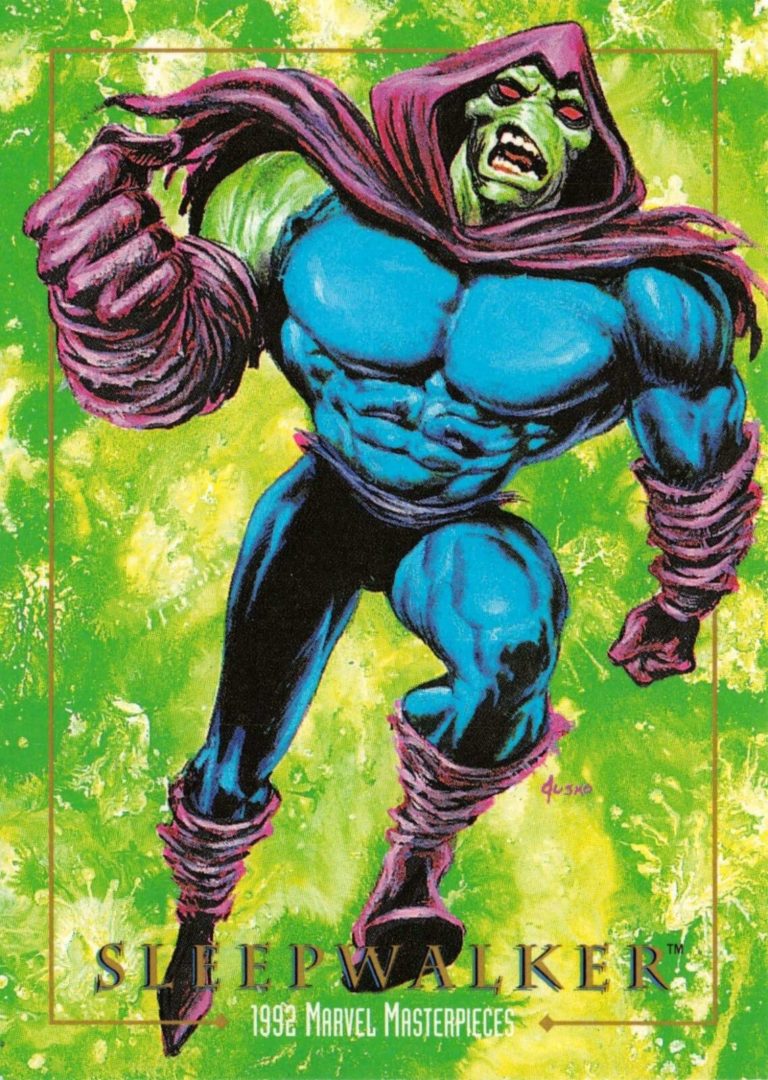
So, kinda straightforward so far. You pay a complicated array of currency to get blind packs of cards to add to your virtual collection. These cards are automatically arranged in tiers, but again, this is handled in a very weird way. You get your ‘Base’ set screens, numbered one through seven, but then you also have screens for common, uncommon, rare, and super rare cards that don’t belong to this base set. You can’t make your own subsets, just in case you wanted to see all of your MODOKs in one place. The fact that you can’t sort your own collection if just kinda straight up offensive.
Trading is confusing. You pick a card you want to trade away, and a card you want, and th3 app gives you a selection of people who have the card you want. Unfortunately, you have no way of knowing if they actually want to trade that card. At this stage, you can see if the person has duplicates of that card which they might be more willing to trade away. Once you’ve chosen your trading partner, you can select more cards to take or add from the trade on both sides, but now, you can’t see if they have duplicates. Rather than pair you up with someone who has multiple cards you need, and wants multiple cards you have, it’s all just low-level chaos and pulling at threads. It would be something if the trade were interactive, but it’s all just short messages shot between people. It’s not especially fun or rewarding.
So, all of this begs the ultimate question: why?
Your collection of cards is completely virtual. It’s a collection of digital pictures that are trapped within the space of an app, but it’s not as if those pictures are even exclusive to you. Anyone can look at them at any time. If you collect enough cards in a set, you get an award… which is just another card. You can’t cash out your cards and get the real things mailed to you, like you can with some of Upper Deck’s e-Pack cards. These Topps cards live on your phone, and only your phone, and they’ll die there when the app shuts down, whenever that may be. There are no prizes. Any sense of advancement within the app, or pride in your collection of small pictures, doesn’t seem all that well-earned; it’s just clicks and images, and money you may have plugged into the endlessly-consuming machine.
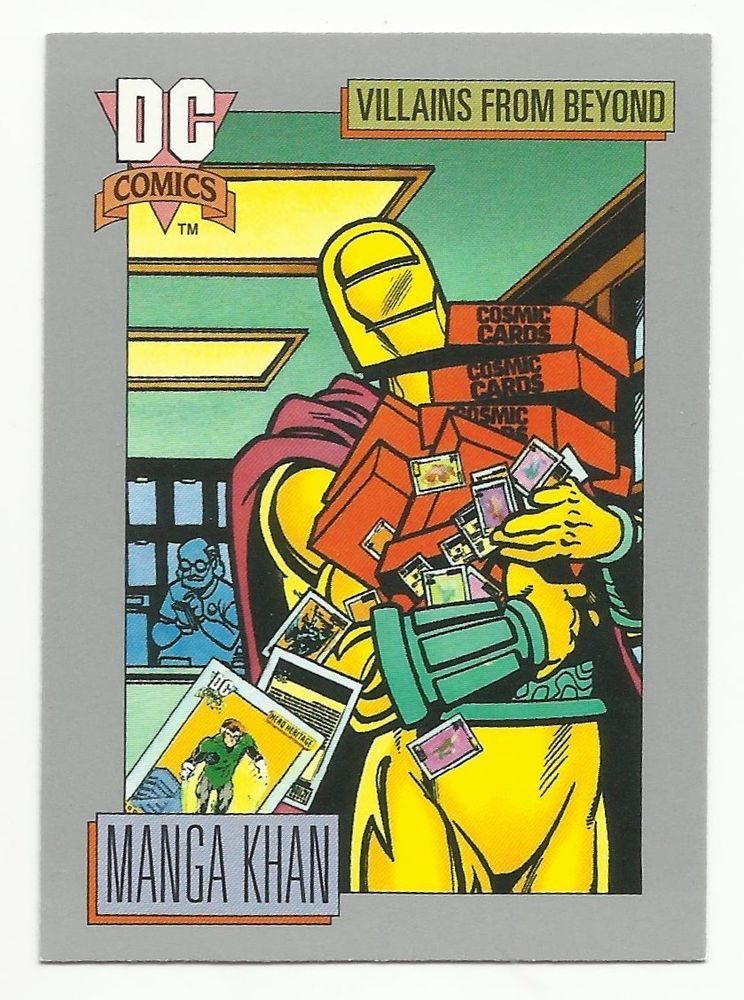
Would it be a little different if each one of these things you’ve paid for with money and time and virtual currency had some kind of use? Like, maybe that Devil Dinosaur could also come with a desktop wallpaper, or a readable comic, or absolutely anything. A character skin in Marvel Ultimate Alliance. A 25-cent-off coupon to Taco Bell. A tip about making a secure email password. A phone number to the suicide hotline. Three seconds of an Oingo Boingo song. I’d take anything at all.
I’m no stranger to the appeal of paying for virtual things; I’ve bought DLC for video games, and I’ve even plugged a few bucks into things like World of Springfield to have characters and objects that would earn other things to build a virtual town. I played Club Penguin after my niece went to sleep so she’d have coins to buy new penguin hats or whatever the next day. I don’t know; I never asked, or played outside of the fishing level. But these cards do nothing.
Or do they?
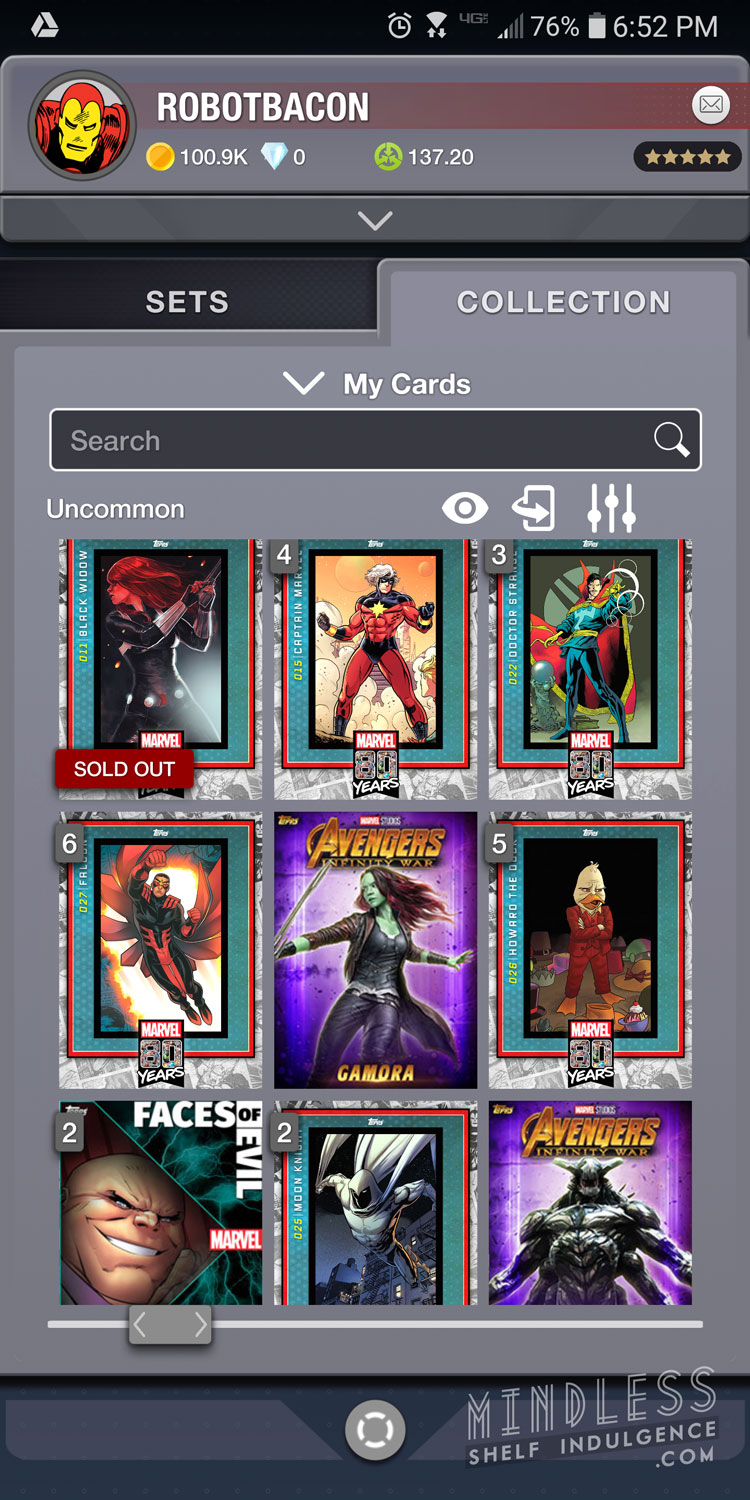
Any app with an in-game trading mechanic can be exploited, and while Topps has locked down much of the buying and selling in their virtual market over the past few years, a small window of opportunity still exists. And within that, you can spend nothing and convert your virtual cards to very small amounts of real-world money. And this is where your useless virtual collection could get interesting.
Until recently, eBay had a ban on the buying and selling of most virtual goods, but virtual trading cards were so popular that the ban was lifted, and eBay now specifically lists these cards as acceptable to sell. If you pull a rare card, or swoop in on a limited edition card, you can flip it on eBay without too much difficulty. And if you give as few hecks as I do about virtual trading cards, there’s none of the usual remorse that comes with selling a beloved object. I’m not advocating a flipper culture here at all, because I loathe when it happens with action figures, but I also think it’s important to figure out how to enjoy things, no matter how hollow they seem.
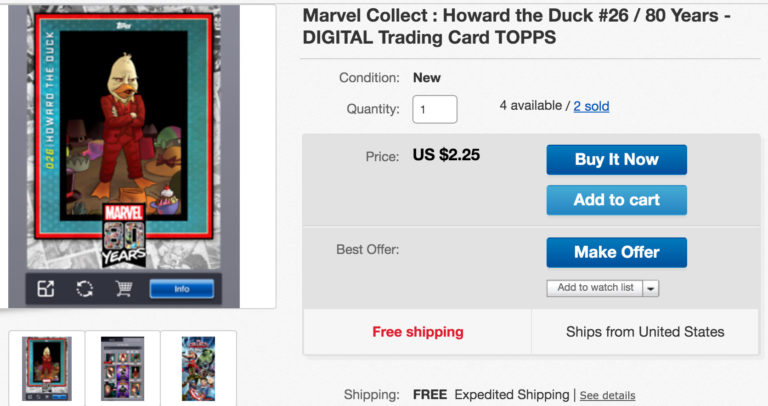
Many of the game’s free trials which net you virtual coins require a credit card for signup, but a nearly-dead Visa or Mastercard gift card usually passes most registration screens, so you won’t have to worry about being billed if you forget to cancel your Funimation trial subscription in 7 days. Free trials with an automatic rebilling date are evil anyhow; like the video stores of yesteryear and the libraries of today, they rely on you forgetting to make a profit (or in the case of libraries, just to survive). If these trials weren’t evil, and they really wanted you to just try out their great service, they wouldn’t even ask for billing information. So, have no remorse for the glorious white lie of impotent gift cards.
With that, you have hundreds of thousands of coins to blow on card packs. Open, fuse, repeat. Focus on limited edition cards.
Within the first 24 hours, I earned (a meager) $7.50 on eBay by selling five cards – a few Howard the Ducks, Falcon, and rare Hawkeye. Maybe birds are just really popular in the app. It’s not a lot, but it was a $7.50 I got for virtual goods I collected while probably sitting on the toilet. That’s a sushi roll. It’s mostway to a new enamel pin. It’s two packs of ACTUAL trading cards. It’s one one-millionth of monthly rent in upstate New York. And it’s also a sweet couple of points on your eBay feedback score. It’s very hard to call this one a loss.
There’s the pervasive myth that physical media is dying, or dead. People are turning their DVD collections into hard drive bits and bytes, a million songs live inside a tiny box in your pocket, and trading cards are now just pictures on your phone. Is one actually more permanent than the other? I’m not totally convinced. It’s somehow strange that ephemera is getting even more ephemeral, but it shouldn’t be a surprise; ‘ephemera’ is in the name of the collecting genre. The world doesn’t really need more paper goods floating around, either.
I’m also an avid card collector; I have many semi-tastefully framed on my walls, from a Galactus collection to dozens of signed Ferengis and Klingons. I’ve even made my own set of trading cards. When it’s all reduced to its most essential form, collecting is two things, both seemingly opposed : enjoyment, and resale value. Marvel Collect has both for collectors, but only the latter for me, and in very small amounts.
 C. David is a writer and artist living in the Hudson Valley, NY. He loves pinball, Wazmo Nariz, Rem Lezar, MODOK, pogs, Ultra Monsters, 80s horror, and is secretly very enthusiastic about everything else not listed here.
C. David is a writer and artist living in the Hudson Valley, NY. He loves pinball, Wazmo Nariz, Rem Lezar, MODOK, pogs, Ultra Monsters, 80s horror, and is secretly very enthusiastic about everything else not listed here.